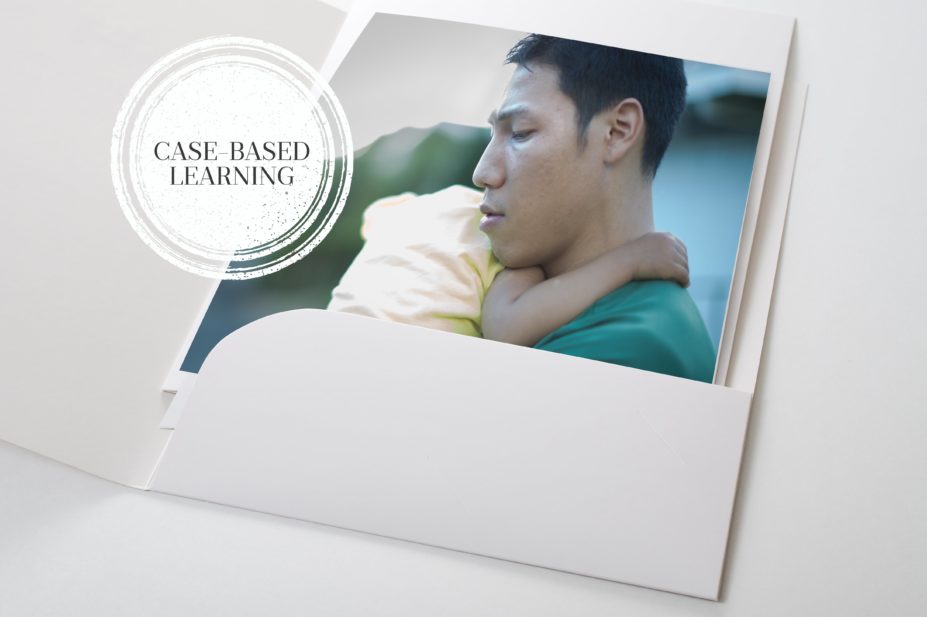
Shutterstock.com
Postnatal depression (PND) is a common, but under-reported, condition that can affect both men and women after the birth of a child[1]
. PND is an illness and not simply related to hormones or the changes a new baby brings. Unlike the ‘baby blues’, which is self-limiting, PND is longer lasting and often requires treatment.
The symptoms of PND are similar to those of depression, such as low self-esteem and persistent low mood, and can range from being relatively mild to severe. Red flag signs include persistent expressions of incompetency as a parent and suicidal thoughts. The greatest risk factor for developing PND is a history of PND or depression, although other risk factors include financial instability and poor social support. Simple screening tools, such as the Whooley questions or Generalised Anxiety Disorder scale, can help identify people at risk of, or who have, PND[2],[3]
. For more information about recognising PND please see here.
Treatment type should be selected based on the severity of the condition and patient preference. Pharmacists can provide advice to patients prescribed antidepressants for PND, including potential side effects and information about breastfeeding. This article describes management and self-care options for patients, including three worked case studies.
Treatment
Asking simple open questions, such as “how are you?”, can be a good way to encourage a new parent to talk without being intrusive. Where a parent shows signs of PND, ask them if they would like to talk about their concerns or if would like any further support. Signposting them to groups available in the area (e.g. community baby groups) can be beneficial.
Avoid comparing the patient with other parents because this can exacerbate feelings of failure. Do not use language that may come across as critical, particularly where parents are worried about how they are coping, and do not suggest that these feelings will simply pass or improve by themselves.
It is important to destigmatise PND and reassure parents about seeking help. Encourage all new parents to look after their emotional wellbeing through self-care, getting support from friends or family, undertaking gentle exercise and eating well[4]
.
Psychological therapy
Cognitive behavioural therapy (CBT) has been shown to be effective for patients with PND, improving symptoms in both the short- and long-term[5],[6],[7]
.
CBT aims to challenge unhelpful thinking patterns through practical activities and helps patients understand their symptoms and illness. Patients are normally offered a course of sessions on a one-to-one basis with a healthcare professional. CBT can also be offered via a group, but individual therapy may be more effective[5],[6],[7]
.
For patients with mild-to-moderate PND, CBT can be recommended. If there are prior episodes of more severe depression, CBT may be offered with antidepressants[8]
. For patients with moderate-to-severe depression, high-intensity psychological therapy (e.g. interpersonal therapy) can initially be offered alone or alongside antidepressants.
Pharmacological therapy
There is little evidence to guide selection of medicine specifically in PND. Therefore, guidelines for managing depression should be followed, taking into account the safety of the medicine for both the mother and, where relevant, the child[9],[10]
.
When selecting an antidepressant, the patient’s previous response to these drugs, as well as previous effective antidepressants should be considered (even if the antidepressant would not be considered as first-line treatment in breastfeeding mothers)[9]
.
Women with PND who choose not to breastfeed and men with PND can both be treated with any suitable antidepressant. However, it is imperative to counsel parents on taking medicines that may cause sedation because they must not co-sleep with their baby (in-line with safe co-sleeping guidance)[11],[12]
.
Breastfeeding and antidepressants
The World Health Organization recommends children are breastfed exclusively for at least the first four to six months of life; however, this can be complicated if the mother requires treatment for depression[13],[14]
. Women with mental health problems should be encouraged to breastfeed unless they are taking clozapine or lithium, because these drugs can pass into breast milk and put the infant at risk of toxicity[9]
.
There is a lack of robust evidence to guide choice of treatment. However, women who wish to breastfeed should be supported to do so and be provided with all available evidence about the risks of the antidepressant and how to limit exposure of the medicine to the baby via breast milk. For example, the level of antidepressant medicine in breast milk depends on the prescribed drug and it is possible to avoid breastfeeding at the time the medicine peaks in the mother, either by timing the medicine around the longest feed or bottle feeding the baby at that time if a feed is due. This may be difficult to achieve in very young babies, however, owing to the frequency of feeding and since many antidepressants have long half-lives or unpredictable times at which they peak. Therefore, a specialist’s advice should be sought regarding this.
Future perspective
Brexanolone is currently in development as a first-line treatment designed specifically to treat PND. It has recently been licensed in the United States, but it is not yet known whether or when it may be marketed in the UK[15]
.
Prevention
Evidence shows that PND that is not recognised and managed early can become difficult to treat and can lead to longer-term illness[16]
. Early psychosocial support is thought to help prevent the development of PND in at-risk mothers[17],[18],[19],[20]
. However, limitations of the current evidence base mean that the effectiveness of specific psychological and pharmacological interventions are not yet conclusive[17],[19],[20]
.
Where women have been taking antidepressants during pregnancy, medication should ideally be continued post-birth owing to the risk of recurrence of depression.
In addition, signposting parents to available groups where they can get professional or peer support may help reduce loneliness and increase social support, which may help prevent PND (see Useful resources).
Case studies
Case study 1: mild postnatal depression in a woman*
A woman aged 21 years comes into the pharmacy to buy something for her three-month-old baby who has colic. When her baby starts to cry, the mother becomes very irritated. She apologises and says she is very tired as the baby has not been sleeping well. She looks teary and upset.
Questions to ask
Offer to talk in the consultation room and ask the following questions to discuss or highlight any issues the mother is facing:
- How are you managing with the baby?
- How is your baby’s constant crying affecting how you feel?
- What support do you have that allows you a break from your baby?
Advice and recommendations
The patient describes mild symptoms of postnatal depression (PND) and has no previous history of a mental health condition; therefore, self-help measures may be beneficial, such as:
- Taking advantage of available support, such as appropriate family members to take a break from the baby or to help manage household chores;
- Sharing day-to-day care of the baby with their partner;
- Eating well and taking gentle exercise (e.g. a walk);
- Attending classes or groups that may be available locally.
Even if the patient is trying self-help measures, it may still be helpful to refer them to their GP or health visitor. Alternatively, recommend ‘Improving Access to Psychological Therapies’ services in the area (people with PND may be able to self-refer without having to see a GP).
Explain that it is common for mothers to have mood disturbances after the birth of a child and that it is important that they address these feelings, rather than hope that they will pass.
Provide the patient with leaflets on PND and how parents can get help, as well as information on local services, numbers to call in an emergency, children’s centres that may offer drop-in sessions, breastfeeding support and any baby groups that parents can attend (see Useful resources).
Case study 2: risk of severe postnatal depression in a woman*
A woman aged 38 years with bad indigestion comes into the pharmacy. She has been taking antacids to ease the symptoms, but the indigestion is not resolving, and she is worried about it. Several years ago, she was treated with escitalopram for depression and anxiety, but has since stopped it. She is not taking any other medicine, has a baby aged three weeks and is struggling with breastfeeding.
Assessment
The patient should be assessed for indigestion; however, it is important to notice the risk factors for postnatal depression (PND) in this patient. Persistent physical symptoms are common in anxiety and depression and should warrant further discussion. Some patients will find it easier to discuss physical problems, which can provide a way for them to open up about other difficulties they may be experiencing.
Ask the patient about:
- Their indigestion – what may be causing it or when it is worst, which may lead to a conversation about how she is feeling or coping;
- Previous episodes of depression – this is the major risk factor for developing PND, therefore, if it has not already been brought up, ask how she is feeling and whether she has any support;
- Breastfeeding – difficulty in establishing breastfeeding is a further risk factor for PND and can exacerbate feelings of failure as a mother. PND is linked to reduced rates of breastfeeding, which can have a negative impact on the mother’s mental health[21]
.
Advice and recommendations
Since the patient wants to continue to try to breastfeed, signpost her to places where she can get help in the local area or find more information (see Useful resources). Feelings of guilt at being unable to breastfeed are common; however, unnecessary blame and feelings of worthlessness should raise serious concerns. This red flag, coupled with her history of depression, means she should be promptly referred to her specialist perinatal mental health team. Different geographic areas require a GP referral, while some allow patients to self-refer.
Reassure the patient about how she is feeling and that there is help and support available to her. Most mental health trusts have a crisis line that operates 24 hours per day and there are charities providing similar support lines (e.g. Samaritans). However, if the patient expresses thoughts about harming herself or her baby, contact their mental health crisis team or GP for an emergency appointment. If the patient has already harmed themselves, call 999.
Potential outcome of the advice
Where there are signs of severe PND and evidence of good prior treatment with antidepressants, it is likely that the patient will be offered antidepressants and psychological therapy. Most mothers will be treated in primary care with follow-up provided by specialist mental health perinatal services.
The previous antidepressant, escitalopram, would be considered for this patient. Many resources will recommend sertraline as first-line treatment in breastfeeding (owing to its shorter half-life and low levels in breastmilk)[22]
. While sertraline will be appropriate for mothers with no prior history of depression, if another antidepressant has had a good response in a previous episode of PND or depression, this will likely be used. In resistant cases, treatment with another antidepressant, lithium or antipsychotic can be considered.
The Specialist Pharmacy Service provides information to healthcare professionals on the safety of medicines in breastmilk[23]
.
Case study 3: perinatal mental health problems in a man*
A man aged 30 years whose partner has recently given birth to their first child comes into the pharmacy. He looks tired and worn out as he collects a prescription for sertraline for his wife. He provides the wrong address and makes a comment about how he always seems to be getting things wrong nowadays and needs to pull himself together.
Assessment
There are fewer opportunities for healthcare professionals to interact with new fathers as most antenatal care involves assessment of the mother and baby. Furthermore, men are also less likely to seek healthcare advice. Therefore, it is important to try and talk to a new father where there is an opportunity.
Ask questions, such as:
- Having a new baby can be stressful – are you both getting some time to rest?
- It can be especially difficult when mum isn’t feeling well – do you have support available to help?
- Are you getting time together with the baby? How are you finding it?
Advice and recommendations
The man explains that he is struggling, feels quite low and that his wife has postnatal depression. Paternal PND has high comorbidity with maternal PND; therefore, children in such families, particularly where PND is left untreated, are at greater risk of emotional and behavioural problems later in life[24]
. Although there is no single official diagnostic criteria for paternal PND[24]
, the man should be referred to his GP because he is at risk.
Reassure the man that PND is common in men and seeking treatment will help. Most of the advice and support groups aimed at women also provide support to men. Furthermore, there is a specific advice group through the PANDAS Foundation for fathers who have PND. In some areas, there are specific baby groups for fathers, which can help to forge peer support, particularly where fathers have limited social networks with other fathers.
Potential outcome of the advice
It is important to encourage the father to seek help and support. It can be helpful to follow up how he is feeling, particularly if he appears ambivalent about taking advice. There is no specific guidance for treating paternal PND and, therefore, usual depression treatment guidelines should be followed[25]
. Treatment may involve psychological interventions or antidepressants. Where antidepressants are used, it is important to consider the effects of medicine and co-sleeping, and to advise that he should not share a bed with a baby[12]
.
*All case studies are fictional.
Useful resources
- Association for Post Natal Illness
- MBRRACE-UK. Saving Lives, Improving Mothers’ Care. Lessons learned to inform maternity care from the UK and Ireland Confidential Enquiries into Maternal Deaths and Morbidity 2014–2016
- Choice and medication
- LactMed – Drugs and Lactation Database
- Start 4 Life. Breast feeding support
- PANDAS helpline 0808 1961 776
How to have effective consultations on contraception in pharmacy
What benefits do long-acting reversible contraceptives offer compared with other available methods?
Community pharmacists can use this summary of the available devices to address misconceptions & provide effective counselling.
Content supported by Bayer
References
[1] Gaynes BN, Gavin N, Meltzer-Brody S et al. Perinatal depression: prevalence, screening accuracy, and screening outcomes. Evid Rep Technol Assess (Summ) 2005;(119):1–8. PMID: 15760246
[2] Howard LM, Ryan EG, Trevillion K et al. Accuracy of the Whooley questions and the Edinburgh Postnatal Depression Scale in identifying depression and other mental disorders in early pregnancy. Br J Psychiatry 2018;212(1):50–56. doi: 10.1192/bjp.2017.9
[3] National Institute for Health and Care Excellence. Identifying and assessing common mental health disorders. 2018. Available at: https://pathways.nice.org.uk/pathways/common-mental-health-disorders-in-primary-care/identifying-and-assessing-common-mental-health-disorders#content=view-node%3Anodes-asking-questions-to-identify-anxiety-disorders (accessed January 2020)
[4] NHS Choices. Postnatal depression. 2018. Available at: https://www.nhs.uk/conditions/post-natal-depression/treatment/ (accessed January 2020)
[5] Kettunen P, Koistinen E & Hintikka J. The connections of pregnancy-, delivery-, and infant-related risk factors and negative life events on postpartum depression and their role in first and recurrent depression. Depress Res Treat 2016;2016:2514317. doi: 10.1155/2016/2514317
[6] Clout D & Brown R. Sociodemographic, pregnancy, obstetric, and postnatal predictors of postpartum stress, anxiety and depression in new mothers. J Affect Disord 2015;188:60–67. doi: 10.1016/J.JAD.2015.08.054
[7] Muraca GM & Joseph KS. The association between maternal age and depression. J Obstet Gynaecol Can 2014;36(9):803–810. doi: 10.1016/S1701–2163(15)30482-5
[8] Sit DKY & Wisner KL. Identification of postpartum depression. Clin Obstet Gynecol 2009;52(3):456–468. PMID: 19661761
[9] National Institute for Health and Care Excellence. Antenatal and postnatal mental health: clinical management and service guidance. Clinical guideline [CG192]. 2018. Available at: https://www.nice.org.uk/guidance/cg192 (accessed January 2020)
[10] National Institute for Health and Care Excellence. Postnatal care up to 8 weeks after birth. Clinical guideline [CG37]. 2015. Available at: https://www.nice.org.uk/guidance/cg37 (accessed January 2020)
[11] McMahon CA, Boivin J, Gibson FL et al. Older maternal age and major depressive episodes in the first two years after birth: findings from the Parental Age and Transition to Parenthood Australia (PATPA) study. J Affect Disord 2015;175:454–462. doi: 10.1016/J.JAD.2015.01.025
[12] The Lullaby Trust. Co-sleeping with your baby. 2013. Available at: https://www.lullabytrust.org.uk/safer-sleep-advice/co-sleeping/ (accessed January 2020)
[13] Mcmahon CA, Boivin J, Gibson FL et al. Older first-time mothers and early postpartum depression: a prospective cohort study of women conceiving spontaneously or with assisted reproductive technologies. Fertil Steril 2011;96:1218–1224. doi: 10.1016/j.fertnstert.2011.08.037
[14] World Health Organization. Health topics: Breastfeeding. 2015. Available at: http://www.who.int/topics/breastfeeding/en/ (accessed January 2020)
[15] National Institute for Health Research. Innovation Observatory. Brexanolone for postpartum depression. 2019. Available at: http://www.io.nihr.ac.uk/wp-content/uploads/2019/01/10557-Brexanolone-for-postpartum-depression-V1.0-JAN2019-NONCONF.pdf (accessed January 2020)
[16] Torres A, Gelabert E, Roca A et al. Course of a major postpartum depressive episode: a prospective 2 years naturalistic follow-up study. J Affect Disord 2019;245:965–970. doi: 10.1016/j.jad.2018.11.062
[17] Boath E, Bradley E & Henshaw C. The prevention of postnatal depression: a narrative systematic review. J Psychosom Obstet Gynecol 2005;26(3):185–192. doi: 10.1080/01674820400028431
[18] Elliott SA, Leverton TJ, Sanjack M et al. Promoting mental health after childbirth: a controlled trial of primary prevention of postnatal depression. Br J Clin Psychol 2000;39(3):223–241. doi: 10.1348/014466500163248
[19] Molyneaux E, Telesia LA, Henshaw C et al. Antidepressants for preventing postnatal depression. Cochrane Database Syst Rev 2018;(4):CD004363. doi: 10.1002/14651858.CD004363.pub3
[20] O’Connor E, Senger CA, Henninger ML et al. Interventions to prevent perinatal depression. JAMA 2019;321(6):588–601. doi: 10.1001/jama.2018.20865
[21] Orsolini L, Valchera A, Vecchiotti R et al. Suicide during perinatal period: epidemiology, risk factors, and clinical correlates. Front Psychiatry 2016;7:138. doi: 10.3389/fpsyt.2016.00138
[22] British Association of Psychopharmacology. BAP consensus guidance on the use of psychotropic medication preconception, in pregnancy and postpartum. 2017. Available at: https://www.bap.org.uk/pdfs/BAP_Guidelines-Perinatal.pdf (accessed January 2020)
[23] Specialist Pharmacy Service. UK Drugs in Lactation Advisory Service (UKDILAS). 2019. Available at: https://www.sps.nhs.uk/articles/ukdilas/ (accessed January 2020)
[24] Kim P & Swain JE. Sad dads: paternal postpartum depression. Psychiatry (Edgmont) 2007;4(2):35–47. PMID: 20805898
[25] Siegel RS & Brandon AR. Adolescents, pregnancy, and mental health. J Pediatr Adolesc Gynecol 2014;27(3):138–150. doi: 10.1016/j.jpag.2013.09.008


